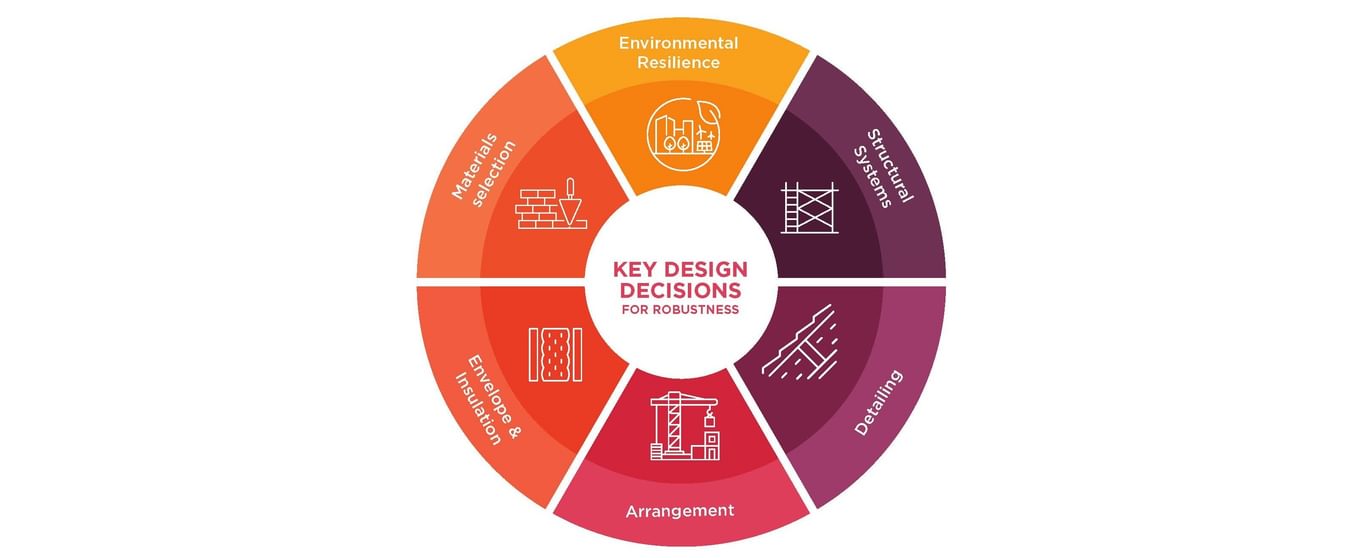
Design for robustness: The silent factor in sustainability
The concept of designing for robustness has been a fundamental principle in Architecture for centuries, but the advent of modern materials and complex detailing makes this more challenging, and this focus is being lost.
We must reconsider this to enhance the Architectural profession's reputation for adding value to our clients and as a fundamental response to the climate crisis and the increasing pressure on material resources.
Robust design ensures buildings can withstand stress and maintain functionality and safety over time. This approach is essential given the changing climate, evolving urban landscape, and the necessity for sustainable and resilient structures.
In this Insight Paper, Director Luke Kendall explores the critical design decisions architects must consider to achieve building 'robustness'.
Understanding robustness
Robustness in architecture refers to a building's ability to endure and perform effectively under various conditions. It must remain safe and functional and retain its aesthetics. This includes resistance to physical deterioration, wear and tear, and environmental impact. It must also be flexible and adaptable, allowing it to withstand changes in the climate or changes in its use.
The key to sustainability
Building fabric with a short life span will increase the need for maintenance and replacement, which adds to the design's environmental impact and carbon footprint. Increased use of materials and transportation, both in the manufacture and the act of maintenance, all need to be factored in when calculating the design's lifecycle cost. Small gains to improve embodied carbon for the initial installation can soon be lost if they need to be maintained or replaced in short time periods.
Key Design decisions for robustness
A designer needs to consider several factors when designing robust buildings, many of which overlap or are sometimes even in tension.
- Material Selection
- Durability: The primary consideration here is the material's lifespan and resistance to wear and tear. Materials such as concrete, steel, and masonry offer high degrees of durability when detailed and applied correctly.
- Weather resistance: The UK's climate, characterised by year-round rainfall and occasional freezing temperatures, demands materials that can withstand these conditions. Materials that stain, rust, or rot when exposed to water must be avoided, as should rigid materials that are suspectable of freezing or thawing cycles.
- Structural systems
- Load-bearing capacity: The structural system must support anticipated loads, including live loads (occupants and furniture) and dead loads (the weight of the building itself). Steel frameworks and reinforced concrete are commonly used in the UK for their high load-bearing capacities and versatility.
- Flexibility and adaptability: Buildings must adapt to changing needs and uses over time. Modular construction techniques, which allow components to be easily replaced or reconfigured, offer robustness by accommodating future modifications without extensive structural changes.
- Envelope and insulation
- Thermal performance: Insulating materials must provide effective thermal resistance to enhance energy efficiency and indoor comfort. High-performing insulation materials, such as rigid foam boards and insulated concrete forms, help maintain internal temperatures despite external fluctuations.
- Moisture control: Effective moisture management is critical to prevent dampness, mold, and structural degradation. Vapor barriers, proper drainage systems, and breathable wall materials ensure moisture does not accumulate within the building envelope.
- Environmental resilience
- Flood Resistance: With the increasing occurrence of floods in certain areas, incorporating flood-resistant design features is vital. Raised foundations, waterproof barriers, and using water-resistant materials at lower levels can mitigate this type of damage.
- Wind resistance: Structures must be designed to withstand high winds, particularly in exposed locations. Aerodynamic shapes, reinforced connections, and wind-resistant cladding materials enhance a building's resilience.
- Detailing
- Ensuring the overlap of materials and devices, such as drip details, can provide natural waterproofing without the need for synthetic sealants while also creating the character and tectonic language of elements vital for good design.
- Flat exposed surfaces or circular transitions between vertical and horizontal are susceptible to staining and require more frequent replacement. The overhangs and details on many older buildings are as practical as they are decorative, allowing water to drip off the building rather than stain the surface.
- Detailing the building by creating areas suitable for its location is vital. Establishing which areas are in contact with people, suspectable to wear, or have significant periods in water needs to be a base principle for detailed design development.
- Arrangement
- Look at the layout of the building, keeping pathways and pedestrian routes away from facades or adding planting to act as a natural barrier to protect vulnerable areas.
- Simplify how building elements connect with linear geometry to create simple and robust details with fewer points of weakness.
Designing for robustness involves a holistic approach that integrates durable materials, resilient structural systems, effective environmental control, and adaptive features. Architects must balance these considerations with sustainability and aesthetic values to create buildings that are not only enduring but also environmentally responsible and visually appealing.
By prioritising robustness, architects can ensure that their designs stand the test of time, adapting to society's evolving needs while withstanding the challenges posed by nature and usage.
Designing for robustness involves a holistic approach that integrates durable materials, resilient structural systems, effective environmental control, and adaptive features. Architects must balance these considerations with sustainability and aesthetic values to create buildings that are not only enduring but also environmentally responsible and visually appealing.
By prioritising robustness, architects can ensure that their designs stand the test of time, adapting to society's evolving needs while withstanding the challenges posed by nature and usage.

